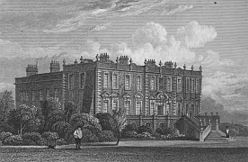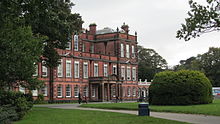- Croxteth Hall
-
Coordinates: 53°26′31″N 2°53′28″W / 53.442°N 2.891°W
Croxteth Hall 
Croxteth Hall in the 1820sGeneral information Town or city Liverpool Country  England
EnglandConstruction started 1575 Croxteth Hall is the former country estate and ancestral home of the Molyneux family, the Earls of Sefton.[1] After the death of the 7th and last Earl in 1972 the estate passed to Liverpool City Council, which now manages the remainder of the estate, following the sale of approximately half of the grounds. The remaining grounds, Croxteth Park, were at one time a hunting chase of the Molyneux family and are now open to the public.[1]
Contents
History
The original house was built in about 1575, and has been expanded in several stages in Tudor, Georgian, and Queen Anne styles. The principal front, the west façade, was built in 1702.
Queen Victoria, Prince Albert and their children stayed at Croxteth Hall on 9 October 1851 before visiting Liverpool the following day during torrential rain. However, the visit started fine with 700 members of the local gentry being entertained in the Hall grounds.[2]
The Hall and its outbuilding are a Grade II* Listed Building, as are 3 of the outbuildings; another 15 buildings on the estate are Grade II. The Molyneux family lived at the Hall from the 16th century until 1972, when the last Earl died. His American-born widow Josephine, Countess of Sefton (1903–1980) - once a close friend of the Duchess of Windsor and nicknamed "Foxy" for her abundant auburn hair - continued to spend some time at Croxteth. She became the last member of the Molyneux family to reside in the hall.
When the last Earl died in 1972, a worldwide search was made for an heir to the title but without success.
Much of the original estate has since been sold off for development, but approximately 500 acres (2 km²) remain as a country park, which is open to the public and includes various play facilities for children. The estate also contains the historic Hall itself, open to the public for a small fee, as well as a maintained Victorian walled garden and a working country farm.
Alleged Haunting
The Liverpool City Council, in whose jurisdiction Croxteth lies, has called for additional investigation into spectral figures which appear to be visible on CCTV security footage of the grounds of Croxteth Hall.[3] Speculation has been raised as to the possible identity of the figure.
The Park
The Grade II listed Park also contains Mull Wood, which is part of the 85 hectares (215 acres) Croxteth Local Nature Reserve. In partnership with Lancashire Wildlife Trust, the reserve been doubled in size. This allows people better access to the reserve areas and include new habitats within the reserve. One of the improvements to Mull Wood is the sowing of a Wildflower Meadow, situated near the Old Kennels.
Myerscough College operate their Liverpool campus from part of the Hall, at which they teach 350 full-time students. See Myerscough College Liverpool Homepage
The "Friends of Croxteth Hall and Country Park" support the work of Liverpool's major stately home. The Friends hold a variety of fun events to raise funds. Among the things they have paid for are benches, plants, equipment, and horticultural studies.
Kennels
The kennels in Croxteth Hall Lane were built in the 1870s and are a Grade II listed building.[4] They were designed by the Chester architect John Douglas for the 4th Earl of Sefton.[5] The kennels are built in red brick with a patterned roof of blue and green slates. The building is in one storey and has three bays; the left two bays consist of the kennels and the bay on the right is higher with a steeper half-hipped roof. There is a tall brick chimney stack.[4]
References
- ^ a b http://www.croxteth.co.uk/attractions/hall/index.asp
- ^ Illustrated London News Oct 1851
- ^ King, Lara (7 April 2009). "Ghostly figure could be Grand National earl Paranormal activity is being investigated at an historic country house, said to be haunted by a former Earl of Sefton.". The Daily Telegraph (London). http://www.telegraph.co.uk/news/uknews/5120198/Ghostly-figure-could-be-Grand-National-earl.html. Retrieved 30 April 2010.
- ^ a b Images of England: Kennels at Croxteth Hall, English Heritage, http://www.imagesofengland.org.uk/details/default.aspx?id=213969, retrieved 26 November 2009
- ^ Hubbard, Edward (1991). The Work of John Douglas. London: The Victorian Society. p. 277. ISBN 0 901657 16 6.
External links
- Official Site
- Dairy
- Details from listed building database (213958 ) . Images of England. English Heritage.
- Buildings at Risk Register: Croxteth+hall
- Croxteth Park Information Site
- Friends of Croxteth Hall
Abercromby Square • Allerton Tower Park • Anfield Crematorium Gardens • Belle Vale Park • Calderstones Park • Canalside Park • Chavasse Park • Church of St Luke • Clarkes Gardens • Croxteth Hall and Country Park • Devonfield Garden • Everton Park • Falkner Square • Gambier Terrace • Greenbank Park • Newsham Park • Otterspool Promenade and Park • Princes Park • Reynolds Park • Sefton Park • Speke and Garston Coastal Reserve • Speke Hall • Springfield Park • Springwood Crematorium Gardens • St. James Mount and Gardens • St. John's Gardens • St. Nicholas Church Gardens • Stanley Park • Sudley Estate • Walton Hall Park • Warbreck Park • Wavertree Botanic Gardens • Wavertree Playground ("The Mystery") • Woolton Woods and CamphillCategories:- Buildings on the Buildings at Risk Register
- Grade II* listed buildings in Liverpool
- Country houses in Merseyside
- Grade II Historic Parks in Liverpool
- John Douglas buildings
- Gardens in Merseyside
- Historic house museums in Merseyside
- Country parks in England
- Reportedly haunted locations in England
- Museums in Liverpool
Wikimedia Foundation. 2010.

